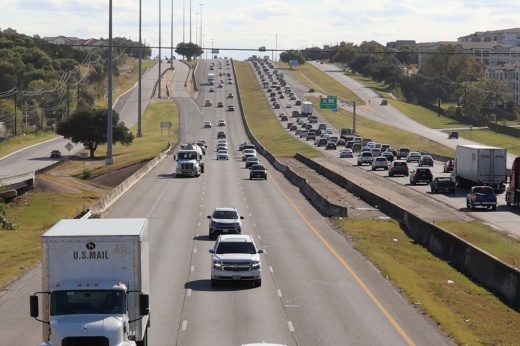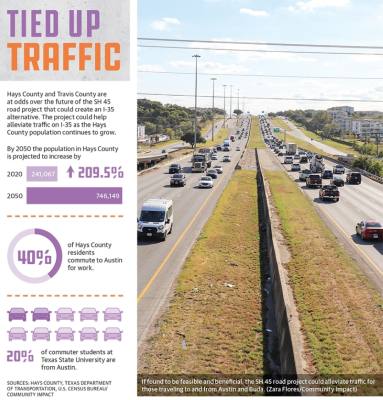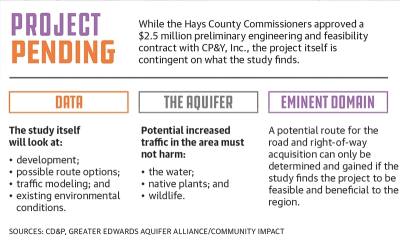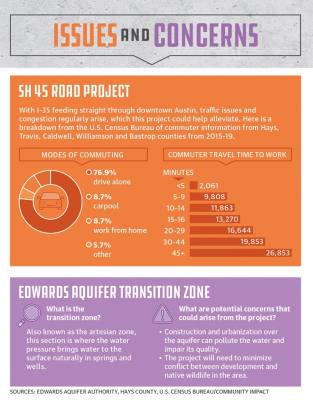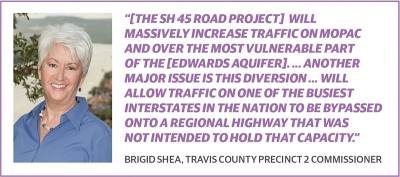Hays and Travis counties significantly increased in population over the course of a decade at 53% and 25% growth, respectively, according to the U.S. Census Bureau.
Major corporations, such as Tesla and Samsung, have also relocated, opting for an Austin-area ZIP code, attracting potential employees to the area.
The rising population has led to an increase in developments and infrastructure throughout Central Texas to accommodate the migration.To this end, some Hays County commissioners are pushing for the completion of the SH 45 road project that would create an I-35 alternative and redirect traffic onto MoPac.
SH 45 sprawls from Buda to Cedar Park, traveling on the east side of I-35. The nearly 4-mile “gap” in question spans from FM 1626 in Manchaca to I-35 in Buda, and straddles the Hays County and Travis County line, which has raised concerns from traffic experts and environmental advocates as construction to complete the road would take place directly over the Edwards Aquifer transition zone.
The commissioners quarrel
The contention this gap has brought about predates the sitting commissioners as support for the existing SH 45 SW fluctuated since the early 2010s. Despite SH 45 SW reaching completion in 2019, the SH 45 road project is in its infancy with no clear path ahead yet. One of the issues facing the project is a lack of agreement between the counties on how the project should move forward.
With the gap split between two counties, both jurisdictions must approve of and collaborate on the project.
On Aug. 30, the Hays County Commissioners Court approved a $2.5 million contract with CP&Y, Inc. for engineering services to complete the project in a 4-1 vote with Judge Ruben Becerra dissenting, citing “conflicting messages.”
Prior to the vote, Hays County commissioners Mark Jones and Walt Smith said they had previously discussed the project with Travis County commissioners Jeffrey Travillion, Ann Howard and Margaret Gomez. Smith’s precinct covers the area where the SH 45 gap is, and Jones used to cover that precinct prior to the redistricting in November 2021.
Initially, Jones said Hays County should look to Travis County for their feedback on the project. “I don’t want to speak for them,” Jones said.
Both he and Smith went on to say the conversations were “very positive.” However, Travis County commissioners voted Sept. 13 to send a letter to Hays County to “make clear our opposition to this action.”
“We are writing this letter to make clear that that is not an accurate portrayal of [Travillion, Gomez and Howard’s] views and furthermore, to explicitly communicate to Hays County our opposition to their action,” Travis County Commissioner Brigid Shea said at the Sept. 13 meeting.
She added that both Travis County and the city of Austin have opposed the construction of this road project, on the record, as it would be built directly over the Edwards Aquifer.
The letter itself also stated that neither the Travis County Transportation plan nor the Capital Area Metropolitan Planning Organization regional transportation plan include the SH 45 road project.
However, the SH 45 gap is in the city of Buda’s Transportation Mobility Master Plan and the Hays County’s Transportation Plan, and is identified for study in the CAMPO Long Range Transportation Plan, according to Arin Gray, CD&P President and member of the SH 45 gap plan study that is underway.
Following the letter from Travis County, Jones told Community Impact his use of the term “very positive” regarded how he felt the conversations regarding SH 45 went with the Travis County commissioners. He added the conversations were purely informational, and he was not seeking approval of any kind for the project.
Regardless of sentiment, Shea said she believes what Smith and Jones have said in court are “not accurate.”
“[Hays County] has refused to acknowledge our request to put their work on hold and, at least, confer with us on what they are doing,” Shea said.
A case against cars
One major argument from the city of Buda and Hays County is that the completion of the gap project would help relieve traffic congestion in the area. As traffic on existing roadways continues to increase, both Hays and Travis county commissioners have worked over the past several years to ensure the counties are planning to meet the needs of future growth.
“There is a lot of pressure from developers who want more road access,” Shea said.
However, some community members believe there are some glaring flaws in the existing infrastructure, planning and transportation in place, according to Farm&City founder Jay Crossley.
Farm&City is a Texas-based nonprofit that works with communities and government agencies to develop sustainable and equitable growth strategies, and improve public transit. The nonprofit promotes healthy cities that do not negatively affect the environment or rural communities.
Regional growth forecasting points to an increase in population in Austin by about 2 million people, Crossley said, which is unavoidable.
“There is not [a] reasonable argument about stopping the region’s growth. But where that growth happens ... who knows? That depends on the actual policies that all the different governments and entities in the region decide,” Crossley said.
The reason Hays County could be pushing for this road is not because of traffic within the county, but for the growth to keep spurring in car-dependent areas, which will push residents to commute into Austin for work, Crossley said.
“Maybe that is a reasonable option for our region, but it is not necessary,” Crossley said. “Do we want sprawl and pollution?”
Looking after the aquifer
While traffic remains a concern, the largest claim against the SH 45 road project is that it would be built over the transition zone of the Edwards Aquifer—a thin strip of land southeast of the recharge zone where limestone that lies over the aquifer is fractured, and has caves and sinkholes, said Annalisa Peace, Executive Director for the Greater Edwards Aquifer Alliance. The transition zone, also called the artesian zone, is often used to pump water out through wells or used when it comes to the surface through its own springs, Peace said.
Since the aquifer is covered in fractures, caves, sinking streams and sinkholes, the Texas Commission on Environmental Quality Edwards Aquifer Protection Program regulates all activities that could potentially pollute the water and other streams connected to it to protect and maintain its standards.
Members of the GEAA have expressed concerns over similar projects, citing roadkill, invasive species, flooding and water pollution.
Road projects that take place in undeveloped areas pose a threat to existing species of wildlife and grasses, which should be approached with as much caution as possible, according to the GEAA.
“It is evident from a variety of studies that increasing urbanization of the Edwards region is impairing water quality,” Peace wrote in a statement regarding another road project over the aquifer.
If the project were to be completed, the increased traffic over “environmentally sensitive lands” would be putting “the region’s water quality and environment at greater risk,” according to the letter from Travis County.
The letter further outlined action that the city of Austin has taken over the past several decades to protect the Edwards Aquifer, including the implementation of the citizen-initiated Save Our Springs Ordinance, a $143 million voter-approved bond to acquire and preserve 27,000 acres of land and a legal commitment to protect rare and endangered species.
Next steps
Any potential risks that the road project may pose to the environment are being studied through the $2.5 million preliminary engineering and feasibility study contract between Hays County and CP&Y, Inc. The study is expected to take about three years to complete and is in the very early stages. The potential for this project to reach a dirt-turning point is contingent on a variety of factors.
“The study will include extensive stakeholder outreach; identification, development and evaluation of possible route options; traffic modeling; environmental existing conditions studies and mapping; and planning-level preliminary engineering,” Gray said in an email to Community Impact.
Discussions and input will be sought from the public and property owners within the boundaries of the gap regarding the potential route of the road. There will also need to be discussions about eminent domain and right-of-way acquisition; however, no immediate dates for when these would occur have been announced.
If the CP&Y, Inc. study finds the project is feasible and a benefit to the region, funding would then need to be secured, and additional studies would need to be conducted to ensure the road is in accordance with the National Environmental Policy Act, according to Gray.
“The findings and results of the current study would be the starting point for future NEPA studies and subsequent project development,” Gray said.Once the NEPA hoops have been jumped through, detailed design and right-of-way acquisition is next; after which it is up to Hays County, regional transportation partners and the Texas Department of Transportation to decide whether to further advance the project.
Katy McAfee contributed to this report




